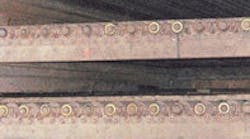Lubrication issues limit the performance of conventional journal, rolling-element and self-lubricating (oil impregnated) bearings. Most bearings don't provide satisfactory life in applications that are hostile to lubricants. Extreme temperatures, grit, vibration, prolonged idle time, corrosives and large loads degrade bearing lubrication. Without the protection a lubricant provides, the bearing suffers metal-to-metal contact, with sudden failure not far behind.
Pick your bearing
Table 1
The big five
Common industrial environments that are too tough for conventional bearings include the following five factors.
Temperature extremes: High temperature is probably the most common cause of premature failure in lubricated bearings. When they're too hot, lubricant migrates from bearing areas and, if the temperature is high enough, carbonizes on the bearing surfaces, preventing them from turning. Also, high-temperature operation can destroy the seals often used to protect ball bearings.
Low temperatures are inhospitable to bearing lubricants, too. It causes them to solidify, which degrades their ability to flow between bearing surfaces.
Vibration:
What often goes unrecognized is that, to a degree, vibration is inevitable in rotating system design. Because conventional metallic bearings and bushings must operate with sufficient clearance to accommodate thermal expansion, there is some play between mating parts.
Corrosives and washout:
Washout is an associated problem. Fluids and semi-fluids passing through pumps and mixers can dissolve bearing lubricants. Although fluids differ in degree -- milk obviously being less of a solvent than xylene -- each tends to wash lubricants from bearings. Steam is a special problem in that it is a hot fluid. Conventional bearings that are washed down will eventually be washed out, regardless of the quality of the seal. Some pumps rely on process fluids for lubrication; these obviously can't use conventional lubricants.
Hanger roll bearings are generally inaccessible and almost impossible to lubricate. Many operate in dry, hot or humid conditions, where carbon-graphite bearings are preferred.
Particulates:
Inactivity:
Solid solution
Eliminating lubricants from a bearing eliminates the associated environmental limitations. For more than 75 years, graphite-metal compounds have been used in conventional bearings that must operate in extreme environments. Graphite is one of the earliest materials to be recognized as a solid lubricant, and continues to be used on applications that are too hot -- above 500F -- for other solid lubricants, such as PTFE or molybdenum disulfide. Graphite derives its low friction characteristics (0.15 to 0.30 coefficient of friction on cold-rolled steel) from its planar structure; the individual plates tend to slip over each other.
By itself, graphite exhibits limited durability. To be used as a bearing, it's alloyed with babbitt, copper, bronze, nickel or silver. Each metal is available in standard bearing and bushing shapes, including flanged bushings, thrust washers and pillow blocks.
The details
Table 2
Properties
Graphite alloy bearings are nearly inert and unaffected by most industrial processing fluids, such as petrochemicals, pulp and paper mill liquor, food compounds (some are FDA approved), acid, steam and most corrosive gases. They are commonly used in remote pump applications in which maintenance is problematic.
In addition, graphite-metal alloy bearings don't melt or cold flow. They can operate in temperatures ranging from -450F to 1,000F, temperatures well beyond the range of traditional lubricants and above the melting point of polymer bearings. Certain grades operate in excess of 1,000F in non-oxidizing atmospheres. Also, bearing material properties change little over the temperature range at which they can be used. Applications include bearings for kilns, furnace conveyors, rollers for dryers, steady bearings, boiler feed systems and pumps for petrochemicals.
Speeds and loads can be determined by conventional PV limits (P is the bearing load in psi and V is the shaft speed in feet per minute). For dry-running conditions, PV is nominally 12,000. However, for applications that are submerged in process fluids, PV can be increased by a factor of seven to 10. Certain combinations of loads and speeds can exceed standard limitations. Some bushings have operated at 60,000 rpm when submerged and 200,000 rpm when gas lubricated. Load can be as high as 1,000 psi, depending on the speed and operating condition.
Compression strength ranges from 15,000 psi to 25,000 psi, depending on the grade of graphite and the metal. Their load capacity makes them suitable for hot material handling devices, furnace conveyors and cart wheels.
Vibration-prone applications, such as pumps with mechanical seals, can benefit from these bearings because their running clearances can be smaller than for alternate bearing materials. These bearings have a coefficient of thermal expansion that is about half that of steel, so shaft clearances are typically in the range of 0.008 to 0.012 in., a dimension that's less than one-third of that required for metallic parts. In fluid handling systems, tight clearances reduce leakage and increase efficiency.
Graphite-metal alloy bearings are more tolerant of foreign particles than are lubricated bearings. Because they use no oil or grease, graphite-metal bearings don't attract or hold grit, so they are often used in kilns and agitators, where dust is present. Table 1 shows some typical families of applications. Table 2 shows when to use graphite-metal bearings.
Eben Walker is general manager for Graphite Metallizing Corp. in Yonkers, N.Y. You can reach him at (914) 968-8400.
Figures: Graphite Metallizing Corp.
